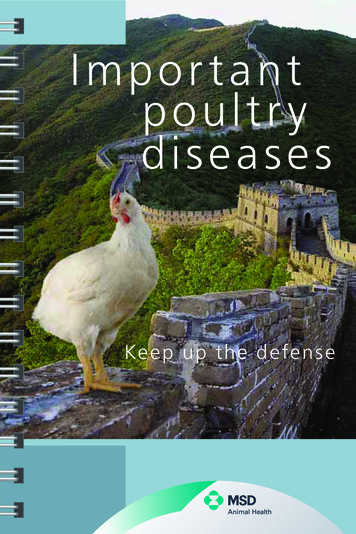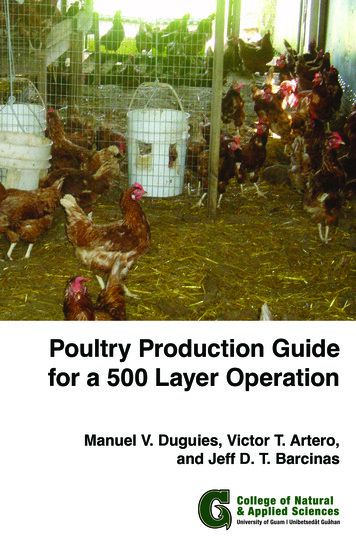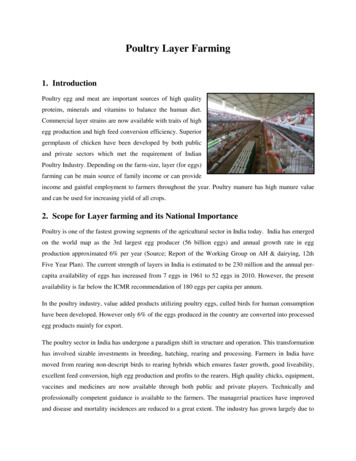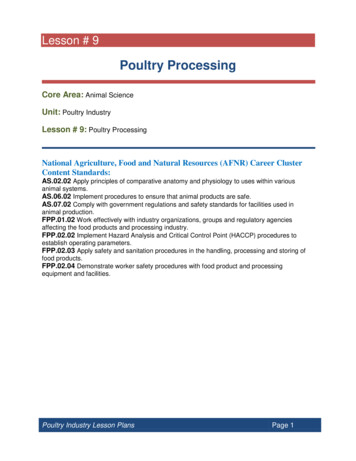
Transcription
*44/ '"0 "/*."- 130%6 5*0/ "/% )&"-5)NBOVBM4."-- 4 "-& 106-53: 130%6 5*0/UFDIOJDBM HVJEF
1FAO ANIMAL PRODUCTION AND HEALTHmanualSMALL-SCALE POULTRY PRODUCTIONtechnical guideE.B. SonaiyaDepartment of Animal ScienceObafemi Awolowo UniversityIle-Ife, NigeriaandS.E.J. SwanVillage Poultry ConsultantWaimana, New ZealandFOOD AND AGRICULTURE ORGANIZATION OF THE UNITED NATIONSRome, 2004
Small-scale poultry productioniiiContentsChapter 1 . 1Introduction . 1Chapter 2 . 7Species and Breeds . 7Chapter 3 . 13Feed Resources. 13Chapter 4 . 23General Management . 23Chapter 5 . 37Incubation and Hatching. 37Chapter 6 . 41Health . 41Chapter 7 . 59Breed Improvement. 59Chapter 8 . 65Production Economics . 65Chapter 9 . 69Marketing . 69Chapter 10 . 85Research and Development for Family Poultry. 85Bibliography. 109
ForewordivForewordKeeping poultry makes a substantial contribution to household food security throughout thedeveloping world. It helps diversify incomes and provides quality food, energy, fertilizer and arenewable asset in over 80 percent of rural households.Small-scale producers are however constrained by poor access to markets, goods andservices; they have weak institutions and lack skills, knowledge and appropriate technologies.The result is that both production and productivity remain well below potential and losses andwastage can be high. However, adapted breeds, local feed resources and appropriate vaccinesare available, along with proven technologies that can substantially improve productivity andincome generation.FAO recognizes the important contribution that poultry can make to poverty alleviation andhas programmes that focus on small-scale, low-input, family based poultry production. Theseprogrammes target the more vulnerable households especially those affected by naturaldisasters, HIV Aids and conflict. This manual provides a comprehensive and valuable technicalguide for those in government service or aid agencies, wishing to embark on projects thatexploit the potential of small-scale poultry production to improve the livelihoods of the ruralpoor. All aspects of small-scale poultry production are discussed in this book including feedingand nutrition, housing, general husbandry and flock health. Regional differences in productionpractices are described.FAO acknowledges and commends the effort that the authors have put into making such acomprehensive and valuable reference for those involved in poultry production in thedeveloping world. The views expressed are, however, those of the authors and do notnecessarily reflect those of FAO. Members of the International Network for Family PoultryDevelopment (INFPD) have been involved in producing and reviewing this document and theircontribution is also gratefully acknowledged. A major aim of the INFPD is to bring together anddisseminate technical information that supports small-scale poultry producers throughout theworld.
Small-scale poultry production1Chapter 1IntroductionThe socio-economic Importance of Family PoultryFamily poultry is defined as small-scale poultry keeping by households using family labour and,wherever possible, locally available feed resources. The poultry may range freely in thehousehold compound and find much of their own food, getting supplementary amounts from thehouseholder. Participants at a 1989 workshop in Ile-Ife, Nigeria, defined rural poultry as a flockof less than 100 birds, of unimproved or improved breed, raised in either extensive or intensivefarming systems. Labour is not salaried, but drawn from the family household (Sonaiya 1990b).Family poultry was additionally clarified as “small flocks managed by individual farm familiesin order to obtain food security, income and gainful employment for women and children”(Branckaert, as cited in Sonaiya, 1990c). Family poultry is quite distinct from medium to largescale commercial poultry farming.Family poultry is rarely the sole means of livelihood for the family but is one of a number ofintegrated and complementary farming activities contributing to the overall well-being of thehousehold. Poultry provide a major income-generating activity from the sale of birds and eggs.Occasional consumption provides a valuable source of protein in the diet. Poultry also play animportant socio-cultural role in many societies. Poultry keeping uses family labour, and women(who often own as well as look after the family flock) are major beneficiaries. Women oftenhave an important role in the development of family poultry production as extension workersand in vaccination programmes.For smallholder farmers in developing countries (especially in low income, food-deficientcountries [LIFDC]), family poultry represents one of the few opportunities for saving,investment and security against risk. In some of these countries, family poultry accounts forapproximately 90 percent of the total poultry production (Branckaert, 1999). In Bangladesh forexample, family poultry represents more than 80 percent of the total poultry production, and 90percent of the 18 million rural households keep poultry. Landless families in Bangladesh form20 percent of the population (Fattah, 1999, citing the Bangladesh Bureau of Statistics, 1998)and they keep between five and seven chickens per household. In LIFDC countries, familypoultry-produced meat and eggs are estimated to contribute 20 to 30 percent of the total animalprotein supply (Alam, 1997, and Branckaert, 1999), taking second place to milk products (38percent), which are mostly imported. Similarly, in Nigeria, family poultry representsapproximately 94 percent of total poultry keeping, and accounts for nearly four percent of thetotal estimated value of the livestock resources in the country. Family poultry represents 83percent of the estimated 82 million adult chickens in Nigeria. In Ethiopia, rural poultry accountsfor 99 percent of the national total production of poultry meat and eggs (Tadelle et al., 2000).Poultry are the smallest livestock investment a village household can make. Yet the povertystricken farmer needs credit assistance even to manage this first investment step on the ladderout of poverty. Poultry keeping is traditionally the role of women in many developing countries.Female-headed households represent 20 to 30 percent of all rural households in Bangladesh(Saleque, 1999), and women are more disadvantaged in terms of options for income generation.In sub-Saharan Africa, 85 percent of all households keep poultry, with women owning 70percent of the poultry. (Guéye, 1998 and Branckaert, 1999, citing World Poultry 14).Income generation is the primary goal of family poultry keeping. Eggs can provide a regular,albeit small, income while the sale of live birds provides a more flexible source of cash asrequired. For example, in the Dominican Republic, family poultry contributes 13 percent of theincome from animal production (Rauen et al., 1990). The importance of poultry to ruralhouseholds is illustrated by the example below from the United Republic of Tanzania (see Table1.1). Assuming an indigenous hen lays 30 eggs per year, of which 50 percent are consumed andthe remainder have a hatchability of 80 percent, then each hen will produce 12 chicks per year.
2IntroductionAssuming six survive to maturity (with 50 percent mortality), and assuming that three pulletsand three are cockerels, the output from one hen projected over five years would total 120 kg ofmeat and 195 (6.8 kg) eggs.Table 1.1 Projected output from a single initial hen (United Republic of Tanzania)TimeNº of hatching eggsNº of cockerelsNº of pulletsNº of cocksNº of hensNº of )082028404860TotalSource: Kabatange and Katule, 1989.A study on income generation in transmigrant farming systems in East Kalimantan, Indonesia(see Table 1.2), showed that family poultry accounted for about 53 percent of the total income,and was used for food, school fees and unexpected expenses such as medicines (Ramm et al.,1984).Flock composition is heavily biased towards chickens in Africa and South Asia, with moreducks in East Asia and South America. Flock size ranges from 5 – 100 in Africa, 10 – 30 inSouth America and 5 – 20 in Asia. Flock size is related to the poultry farming objectives of:x home consumption only;x home consumption and cultural reasons;x income and home consumption; andx income only.(See Table 1.3.)In Bangladesh (Jensen, 1999), the average production rate per local hen of 50 eggs/year wasregarded by some as low productivity. However, if it is considered that 50 eggs per hen per yearrepresents four hatches from four clutches of eggs laid, incubated and hatched by the motherhen, and the outcome is 30 saleable chicken reared per year (assuming no eggs sold or eaten, 80percent hatchability and 25 percent rearing mortality), then it is a remarkably high productivity.PRODUCTION SYSTEMSFamily poultry are kept under a wide range of conditions, which can be classified into one offour broad production systems (Bessei, 1987):x free-range extensive;x backyard extensive;x semi-intensive; andx intensive.Indicative production levels for the different systems are summarized in Table 1.4.
3Small-scale poultry productionTable 1.2 Annual budget for a family farm with 0.4 ha irrigated paddy, 0.1 ha vegetablegarden, 100 ducks and two buffaloes in IndonesiaUnitRupeesAnnual expensesCropsAnimals:- Buffaloes- Ducks1 198 0001 147 200SubtotalAnnual revenueCrops:- Maize- Rice- Cassava- Peanut- Soybean- Mixed gardenSubtotal CropsAnimals:- Buffaloes - meat- draftSubtotal Buffaloes- Ducks- eggs2 345 200240 kg4 000 kg600 kg60 kg60 kg96 0002 000 00060 00060 00030 000150 0002 396 000150 kg30 days300 000180 000480 00013 140 eggs5 256 000Subtotal Animals5 736 0001 198 000(20.7%)Annual net return to family labour from cropsAnnual net return to family labour from livestock- Buffaloes480 000(8.3%)4 108 800(71.0%)- Ducks5 786 800(100%)Total return to family labour from agricultureSource: Setioko, 1997.Table 1.3 Flock size and poultry farming objectives in NigeriaObjectivesHome consumption onlyHome consumption and cultural reasonsIncome and home consumptionIncome onlySource: Sonaiya, 1990a.Flock size1-101-1011-30 50% of sample304410.5
4IntroductionFree-Range Extensive SystemsIn Africa, Asia and Latin America, 80 percent of farmers keep poultry in the first two extensivesystems. Under free-range conditions, the birds are not confined and can scavenge for food overa wide area. Rudimentary shelters may be provided, and these may or may not be used. Thebirds may roost outside, usually in trees, and nest in the bush. The flock contains birds ofdifferent species and varying ages.Backyard Extensive SystemsPoultry are housed at night but allowed free-range during the day. They are usually fed ahandful of grain in the morning and evening to supplement scavenging.Semi-Intensive SystemsThese are a combination of the extensive and intensive systems where birds are confined to acertain area with access to shelter. They are commonly found in urban and peri-urban as well asrural situations. In the “run” system, the birds are confined in an enclosed area outside duringthe day and housed at night. Feed and water are available in the house to avoid wastage by rain,wind and wild animals.In the European system of free-range poultry keeping, there are two other types of housing.The first of these is the “ark” system, where the poultry are confined overnight (for securityagainst predators) in a building mounted on two rails or skids (usually wooden), which enable itto be moved from place to place with draught power. A typical size is 2 2.5 m to hold about40 birds.The second type of housing is the “fold” unit, with a space allowance (stock density) foradult birds of typically 3 to 4 birds per square metre (birds/m2), both inside and (at least this)outside. The fold unit is usually small enough to be moved by one person. Neither of these twosystems is commonly found in developing countries.Intensive SystemsThese systems are used by medium to large-scale commercial enterprises, and are also used atthe household level. Birds are fully confined either in houses or cages. Capital outlay is higherand the birds are totally dependent on their owners for all their requirements; productionhowever is higher. There are three types of intensive systems:2x Deep litter system: birds are fully confined (with floor space allowance of 3 to 4 birds/mwithin a house, but can move around freely. The floor is covered with a deep litter (a 5 to10 cm deep layer) of grain husks (maize or rice), straw, wood shavings or a similarlyabsorbent (but non-toxic) material. The fully enclosed system protects the birds from thievesand predators and is suitable for specially selected commercial breeds of egg or meatproducing poultry (layers, breeder flocks and broilers).x Slatted floor system: wire or wooden slatted floors are used instead of deep litter, whichallow stocking rates to be increased to five birds/m2 of floor space. Birds have reducedcontact with faeces and are allowed some freedom of movement.x Battery cage system: this is usually used for laying birds, which are kept throughout theirproductive life in cages. There is a high initial capital investment, and the system is mostlyconfined to large-scale commercial egg layer operations.Intensive systems of rearing indigenous chickens commercially is uncommon, a notable rareexception being in Malaysia, where the industry developed in response to the heavy demand forindigenous chickens in urban areas (Supramaniam, 1988). However, this accounts for only twoin every 100 000 (0.002 percent) of that country’s indigenous chicken.
5Small-scale poultry productionTable 1.4 Production and reproduction per hen per year under the different managementsystemsProduction systemScavenging (free-range)Improved scavenging1/Semi-intensiveIntensive (deep litter)Intensive (cages)Nº of eggs perhen/yearNº of year-oldchickensNº of eggs forconsumption -010-2030-5050-60180-2201/improved shelter and Newcastle Disease vaccinationSource: Bessei, 1987.The above management systems frequently overlap. Thus free-range is sometimes coupled withfeed supplementation, backyard with night confinement but without feeding, and poultry cagesin confined spaces (Branckaert and Guèye, 1999).ConclusionsOver the last decade, the consumption of poultry products in developing countries has grown by5.8 percent per annum, faster than that of human population growth, and has created a greatincrease in demand. Family poultry has the potential to satisfy at least part of this demandthrough increased productivity and reduced wastage and losses, yet still represent essentiallylow-input production systems. If production from family poultry is to remain sustainable, itmust continue to emphasize the use of family labour, adapted breeds and better management ofstock health and local feed resources. This does not exclude the introduction of appropriate newtechnologies, which need not be sophisticated. However, technologies involving substantiallyincreased inputs, particularly if they are expensive (such as imported concentrate feeds orgenetic material) should be avoided. This is not to say that such technologies do not have aplace in the large-scale commercial sector, where their use is largely determined by economicconsiderations.Development initiatives in the past have emphasized genetic improvement, usually throughthe introduction of exotic genes, arguing that improved feed would have no effect on indigenousbirds of low genetic potential. There is a growing awareness of the need to balance the rate ofgenetic improvement with improvement in feed availability, health care and management. Thereis also an increased recognition of the potential of indigenous breeds and their role in convertinglocally available feed resources into sustainable production.This manual aims to provide those involved with poultry development in developingcountries with a practical guide and insight into the potential of family poultry to improve rurallivelihoods and to meet the increasing demand for poultry products.
Small-scale poultry production7Chapter 2Species and BreedsDifferent Poultry Species and BreedsAll species of poultry are used by rural smallholders throughout the world. The most importantspecies in the tropics are: chickens, guinea fowl, ducks (including Muscovy ducks), pigeons,turkeys and geese. Local strains are used, but most species are not indigenous. The guinea fowl(Numididae) originated in West Africa; the Muscovy duck (Cairina moschata) in SouthAmerica; pigeons (Columba livea) in Europe; turkeys (Meleagrididae) in Latin America;pheasants (Phasianidae) in Asia; the common duck (Anas) in Europe; and geese (Anser) inAsia.Flock composition is determined by the objectives of the poultry enterprise (see Chapter 1).In Nigeria for example, the preference is for the smooth-feathered, multicoloured nativechickens or Muscovy ducks. Multicoloured feathers serve as camouflage for scavenging birdsagainst predators, including birds of prey, which can more easily see solid colours (especiallywhite). Foundation stock is usually obtained from the market as grower pullets and youngcockerels. A hen to cock ratio of about 5:1 is common. Both sexes are retained for 150 to 300days, for the purposes of culling, selling, home consumption and gifts, most of which requireadult birds.In the last 50 years, there has been a great advance in the development of hybrid breeds forintensive commercial poultry production. This trend is most noticeable in chickens, turkeys andducks. The new hybrids (those of chickens in particular) are widely distributed and are presentin every country in the tropics, even in the most remote villages. The hybrids have beencarefully selected and specialised solely for the production of either meat or eggs. These endproduct-specialised hybrid strains are unsuitable for breeding purposes, especially for mixingwith local village scavenger stock, as they have very low mothering ability and broodiness.For the smallholder, keeping hybrids means considerable changes are required inmanagement. These changes are expensive for the following reasons:x All replacement day-old chicks must be purchased.x Hatchery chicks require artificial brooding and special starting feed.x Hybrids require higher quality balanced feed for optimum meat and egg production.x Hybrids require more careful veterinary hygiene and disease management.x Egg-laying hybrid hens require supplementary artificial light (a steadily increasing daylength up to 17 hours of total light per day) for optimum (profitable) egg production.The meat and eggs from intensively raised hybrid stock are considered by many traditionalconsumers to have less flavour, and the meat to have too soft a texture. Consumers will thusoften pay a higher price for village-produced poultry meat and eggs. Thus for rural familypoultry keepers, it is more appropriate to maintain and improve local birds to meet this demand.ChickensChickens originated in Southeast Asia and were introduced to the rest of the world by sailorsand traders. Nowadays, indigenous village chickens are the result of centuries of cross-breedingwith exotic breeds and random breeding within the flock. As a result, it is not possible tostandardize the characteristics and productive performance of indigenous chickens.There is no comprehensive list of the breeds and varieties of chickens used by ruralsmallholders, but there is considerable information on some indigenous populations fromvarious regions. Most of this is based on feather colour and other easily measured body features(genetic traits), but more detailed data are becoming available. Examples of local chickens fromdifferent parts of the tropics are given in Tables 2.1 to 2.3 below. These evaluations wereusually carried out under intensive management conditions in research stations, as the objectivewas to evaluate the local birds’ productivity. More recently, data on the performance of local
8Species and Breedschickens under extensive management have become available, which makes it possible tocompare performance under extensive and intensive systems (see Table 2.3).Table 2.1 Performance of local breeds in South Asia (intensively housed)TraitsDesiNaked NeckAseelKadak-anathBlack Bengal12 wk live wt (g)Age at 1st egg (d)Eggs/hen/yearEgg wt (g)Fertility (%)Hatchability A80399061433200NA498668Source: Acharya and Kumar, 1984. Desi means “local” (as in Bangladeshi)Characteristics such as adult body weight and egg weight vary considerably among indigenouschicken populations, although reproductive traits, such as the number of laying seasons peryear, the number of eggs per clutch and hatchability are more consistent. Desi hens inBangladesh range from 190 to 200 days of age at first egg (an easy measure of age-at-sexualmaturity), and they lay 10 to 15 eggs per season in 3 to 4 clutches (3 to 4 times) per year, with ahatchability of 84 to 87 percent (percent of eggs set) (Haque , 1999).Table 2.2 Local chicken breeds of EthiopiaTraits24 wk body wt (g)Age at 1st egg (d)Eggs/bird.yrEgg wt (g)Fertility (%)Hatchability 9Source: Shanawany & Banerjee, 1991 as cited in Forssido, 1986; Australian Agricultural Consultancyand Management Company, 1984; Beker and Banerjee, 1990.Indigenous village birds in Ethiopia attain sexual maturity at an average age of seven months(214 days). The hen lays about 36 eggs per year in three clutches of 12 to 13 eggs in about 16days. If the hen incubates her eggs for three weeks and then rears the chicks for twelve weeks,then each reproductive cycle lasts for 17 weeks. Three cycles then make one year. These arevery efficient, productive and essential traits for survival.Guinea fowlGuinea fowl are native to West Africa but are now found in many parts of the tropics, and arekept in large numbers under intensive systems in France, Italy, the former Soviet Union andHungary. In India, guinea fowl are raised in parts of the Punjab (Shingari et al., 1994), UttarPradesh, Assam and Madhya Pradesh, usually in flocks of a few hundred birds. Guinea fowl areseasonal breeders, laying eggs only during the rainy season, under free-range conditions. Theyare very timid, roosting in trees at night, and although great walkers, they fly very little.Guinea fowl thrive in both cool and hot conditions, and their potential to increase meat andparticularly egg production in developing countries deserves better recognition. The first egg isnormally laid at about 18 weeks of age, and unlike many indigenous birds (which produce asingle clutch a year), guinea hens lay continuously until adverse weather sets in. In West Africa,laying is largely confined to the rainy season. Guinea hens under free-range conditions can lay
9Small-scale poultry productionup to 60 eggs per season, while well-managed birds under intensive management can lay up to200 eggs per year. The guinea hen “goes broody” (sits on eggs in the nest) after laying, but thiscan be overcome by removing most of the eggs. A clutch of 15 to 20 eggs is common, and theincubation period for guinea fowl is 27 days. Domesticated guinea fowl under extensive orsemi-intensive management in Nigeria were reported to lay 60 to 100 eggs with a fertility rate of40 to 60 percent.Table 2.3 Performance of local chicken breeds under scavenging and intensive managementsystemsSystemScavengingAfricaAsiaLatin AmericaIntensiveAfricaAsiaCountryBreedBodyEggEggWt (g)NºWt (g)BurundiLocal1 5007540MaliLocal1 170353441United Rep.TanzaniaLocal1 20070IndonesiaKampung2 00035-MalaysiaKampung1 4305539BangladeshLocal1 1404037ThailandThai1 4004048ThailandBetong1 9001845ThailandSamae2 30070-Dom. Rep.Local1 50010038BoliviaLocal1 500100-1 i1 33015140NigeriaLocal1 50012536United Rep. TanzaniaLocal1 65210946UgandaLocal1 5004050ZambiaLocal1 5003552BangladeshDesi1 3004535IndiaKadakanath1 1258040IndonesiaAyam Nunukan2 00015048IndonesiaAyam Kampung1 35010445Sources: Compiled from Horst, 1989; Katule, 1991; Horst et al., 1996; Haque, 1999.Domesticated guinea fowl are of three principal varieties: Pearl, White and Lavender. The Pearlis by far the most common. It has purplish-grey feathers regularly dotted or “pearled” withwhite. The White guinea fowl has pure white feathers while the Lavender has light grey feathersdotted with white. The male and female guinea fowl differ so little in appearance (feather colourand body weight [1.4 to 1.6 kg]) that the inexperienced farmer may unknowingly keep all malesor all females as “breeding” stock. Sex can be distinguished at eight weeks or more by adifference in their voice cry.Domesticated guinea hens lay more eggs under intensive management. French Galor guineahens can produce 170 eggs in a 36-week laying period. For example, from a setting of 155 eggs,a fertility rate of 88 percent and hatchability of 70 to 75 percent, it is possible to obtain 115guinea keets (chicks) per hen. In deep litter or confined range conditions, a 24-week layingperiod can produce 50 to 75 guinea keets per hen.Table 2.4 Reproduction and egg characteristics of guinea fowl varieties
10Species and BreedsTraitsPearlstAge at 1 egg (d)Eggs/hen/yearEgg wt (g)Laying (d/yr)Fertility (%)Hatchability e2944336920.00.0Source: Ayorinde, 1987 and Ayorinde et al., 1984.DucksDucks have several advantages over other poultry species, in particular their disease tolerance.They are hardy, excellent foragers and easy to herd, particularly in wetlands where they tend toflock together. In Asia, most duck production is closely associated with wetland rice farming,particularly in the humid and subtropics. An added advantage is that ducks normally lay most oftheir eggs within the three hours after sunrise (compared with five hours for chickens). Thismakes it possible for ducks to freely range in the rice fields by day, while being confined bynight. A disadvantage of ducks (relative to other poultry), when kept in confinement and fedbalanced rations, is their high feed wastage, due to the shovel-shape of their bill. This makestheir use of feed less efficient and thus their meat and eggs more expensive than those ofchickens (Farrell, 1986). Duck feathers and feather down can also make an importantcontribution to income.Different breeds of ducks are usually grouped into three classes: meat or general purpose;egg production; and ornamental.Ornamental ducks are rarely found in the family poultry sector. Meat breeds include thePekin, Muscovy, Rouen and Aylesbury. Egg breeds include the brown Tsaiya of TaiwanProvince of China, the Patero Grade of the Philippines, the Indian Runner of Malaysia and theKhaki Campbell of England. All these laying breed ducks originate from the green-headedMallard (Anas platyrhynchos platyrhynchos). The average egg production of the egg breeds isapproximately 70 percent (hen.day basis). The Indian Runner, Khaki Campbell, Pekin andMuscovy are the most important breeds in rural poultry.The Indian RunnerThis is a very active breed, native to Asia, and ideal for free-range. It is a very good egg layerand needs less water than most other breeds, requiring only a basin in which it can immerse itsbeak up to the nostrils. It is the most graceful and elegant of all ducks on land with its uprightcarriage and slim body. It stands at an angle of about 80q to the ground but when startled can bealmost perpendicular.The Khaki CampbellOriginally bred in England, this breed is derived from three breeds: the wild Mallard, the Rouenand the Indian Runner. The female has an overall khaki colour, and the male has a bronze-greenhead. The female is best known for her prolific egg laying ability, with an average of 90 percent(on a hen
Small-scale poultry production 3 Table 1.2 Annual budget for a family farm with 0.4 ha irrigated paddy, 0.1 ha vegetable garden, 100 ducks and two buffaloes in Indonesia Unit Ru










